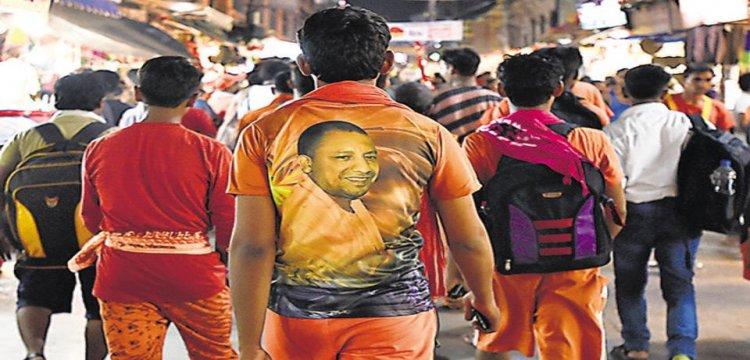How Yogi’s Hindutva Hijacks Kanwar Yatra

Image Courtesy: Ommcom news
As this year’s annual kanwar yatra reaches its end, we can clearly visualise how this tradition has changed and the implications that holds for Indian secularism. With every passing year, the services and gestures of goodwill extended to the kanwariyas by the government of Uttar Pradesh have grown. Concomitant with state patronage, participation in the yatra has grown exponentially too.
In the Hindu tradition, the kanwariya is considered a part of Shiva. That is why they are known as Bholey, which is one of the names of Shiva. For the duration of their yatra, caste, class and regional identities are supposed to vanish. The kanwariyas would only refer to each other as Bholey. In this circumstance, when differences are erased, the only identity that remains is that of being a Hindu. This shared identity also becomes a source of the common power of the kanwariya. This is the key psychological dimension of the kanwar yatra.
A decade ago, the kanwariyas did not have slogans as such. They would chant ‘jai bholey’ or something along those lines. Now, folk songs are remixed and propagated specially for these yatras. The kanwariyas have also become stridently competitive. They compete for the most powerful—or noisiest—DJ. Their bhajans are based on film music and set to dance tunes. Often, these songs eulogise their political benefactors and berate the other. Folk songs, which are not regulated in any way, have been remixed especially for such purposes, often to convey aggression mixed with pride.
When you feel “pride” in it, your yatra transforms into an excursion. The kanwar yatra is an excursion for 15-to-35-year-old rural youth, who are free during the monsoon halt in farming. So, this yatra has become a mix of faith, religion and enjoyment. It does not have just one colour or flavour. But many new flavours are being added to it. One is that the kanwariya is being made to realise that he has joined a large crowd that shares a common belief.
In different ways, the state justifies the beliefs of the kanwariya. They have been getting VIP treatment from the state government. Rose petals are showered on them by district officials. A photograph recently emerged of the Superintendent of Police in Shamli massaging the feet of a tired kanwariya. He defended his action, saying the police have diverse roles in different situations.
The number of kanwariyas is growing exponentially. This year, the highway from Meerut to Haridwar is virtually blocked for their journey. Three years ago, this was not considered necessary. The camps set up to make life easier for them have also increased. There are thousands of such camps, offering free food, refreshment, a place to rest, and so on.
The administration of Chief Minister Yogi Adityanath does not try to discipline the rowdy kanwariyas either. This mollycoddling is part of the state patronage that is being extended to the event.
Faith, of course, propels the kanwar yatra. With growing participation, it will need more and more space and facilities. The state government seems inclined to support this trend. Over the years, the kanwariyas have started to believe that since they are doing dharmic work, nobody should come in their way. This is because their expectations are being actively raised. Preparations for this yatra are on par with election preparations now. The officials deputed for the journey and the sheer expense on managing it are tremendous.
Occasionally, the kanwariyas, who are becoming aware of their power, get into violent fights. This is because of the perception that has been created in them that during the yatra the roads belong to them. The state government’s open participation in the kanwar yatra fuels this perception.
If the government goes all out for a religious event then the idea that the state will remain neutral in matters of religion—the idea that underpins Indian secularism—disappears. Around five years ago, the kanwariyas started carrying the Tricolour. This year, they are wearing t-shirts with portraits of Prime Minister Narendra Modi and the chief minister of UP, Yogi Adityanath. The faces of both leaders appear next to the representations of Shiva on these t-shirts.
Many other things, good and bad, become part of a religious event that gets state sponsorship. For example, statues of deities start drinking milk. This year Nandi, the holy bull associated with Shiva, “drank milk”. When such stories start spreading, you can be sure that the work of politics is done.
With such alterations the kanwar yatra now resembles the 1990 Ram temple ‘yatra’ of former deputy Prime Minister LK Advani. It is now a political journey, in the same sense as that yatra, mixing faith with government and political party.
The kanwariyas include those who are faithful—but faith does not expand exponentially on its own. Such an expansion requires political and state patronage. But what do the yatris get from such sponsorship? First, the services provided by the state makes their journey less arduous. More importantly, their religious status gets enhanced. Third, the yatra becomes a way to practice their religion in terms of a numbers game.
In the multi-layered implications of the kanwar yatra, there now exists a layer of competitive religiosity as well. Somewhere, the yatra has started to resemble the namaz read on Eid. This event has been patronised in an environment that encourages people to believe that ‘Hindus should do something too’. This is also why the number of participants in the yatra has been growing. As a result, it now includes people who have been Hinduised, and merged with the faithful. Finally, somehow, people have also been convinced that they will get something, some kind of benefit, out of this yatra. The Nandi who drinks milk is an essential prop in creating this kind of perception: For ordinary people, such occurrences serve to confirm belief.
When competitive religiosity and a sense of potential benefits combine, the third aspect of such a project produces itself automatically: The subaltern section of society contributes the most active participants in the kanwar yatra. This section starts believing that they are being elevated in status by their participation. They are sold the notion that merely by being part of this religious event, their status has become equivalent to that of a Brahmin. The underlying motive behind creating such perceptions is Sanskritisation. The kanwariyas, at least for a short while, become the heroes of a grand journey which is simultaneously spiritual and practical.
The psychological aspect of this yatra discussed earlier effaces other identities to create a pilgrim who is only a Hindu. That aspect now comes into play as a powerful opportunity to make large crowds feel interested in Hindutva.
In Shamli, I have seen this yatra transform from a walk into a festival and then into a procession over the last few years. This change is entrenched by Hindutva and further expanded by the state government’s declared policy to treat it as a procession. This process has created something unique out of the simple kanwar yatra. Earlier, only one or two individuals from a given village would attempt this journey. The rest of the village would regard them as special and unique for participating in something arduous. Now, large crowds are being made to feel special and unique because of the kind of treatment and services they get from the state.
During the term of the Akhilesh Yadav government, a Rs 100 crore sidewalk was constructed for the kanwariyas, along the Upper Ganga Canal. The Samajwadi Party government had also seen an opportunity in the kanwar yatra, but of a different kind. They, too, organised camps offering food and other amenities and also included Muslims in the preparations and services. In Shamli, the minority cell of the SP set up such camps to reduce the distance between the Hindus and the Muslims of western UP. Since helping the kanwariyas is seen as a kind of social service, many Muslims still get involved in assisting the kanwariyas.
But for a section of kanwariyas, this journey has become a way to feel proud. This sense of pride lubricates the Hindutva project, the ultimate aim of which is to brainwash all Hindus to think alike—in political terms. That project has not fully taken hold of the kanwar yatra because for a majority of pilgrims the driving force is still religious salvation.
The massive increase in participation means that new groups are joining the kanwar yatra, not just new individuals. For instance, the Jats have started participating in large numbers compared with earlier years. In Meerut, various groups announced their participation with signs and banners that identified them by caste and region as Dak Kanwars, Jats, Gujjars, Yadavs or Tyagis. These groups seemed to be the most enthusiastic participants, judging by the number of banners they had put up. This is quite unlike the earlier notion of “Bholey” beyond caste or regional identity.
The camps set up to provide for the kanwariyas also displayed their caste, social and political affiliations: The Agarwal Mandal announced its presence through posters and banners, the Jains did so too, and so on. I saw this happen for the first time. Though many elite-castes had organised these camps, the actual kanwariyas still are largely from subaltern groups—the dalits and the backward sections. Recently a media report pointed out that while the Bahujans are busy with this religious event, the elite-caste members are busy preparing for IAS and other competitive exams. Nobody has researched this aspect of the yatra, but it rings much too true.
Professor Sudhir Panwar is a political analyst and native of Shamli.
Get the latest reports & analysis with people's perspective on Protests, movements & deep analytical videos, discussions of the current affairs in your Telegram app. Subscribe to NewsClick's Telegram channel & get Real-Time updates on stories, as they get published on our website.
























